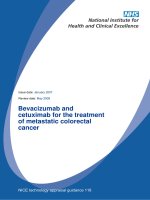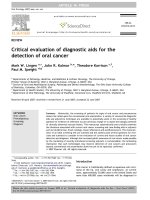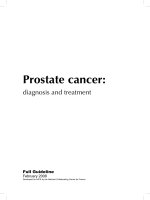Treatment Choices for Men With Early-Stage Prostate Cancer doc
Bạn đang xem bản rút gọn của tài liệu. Xem và tải ngay bản đầy đủ của tài liệu tại đây (1.09 MB, 44 trang )
Treatment Choices
for Men
With Early-Stage
Prostate Cancer
National Cancer Institute
U.S. DEPARTMENT
OF HEALTH AND
HUMAN SERVICES
National Institutes
of Health
ings to Remember
ere are many men with prostate cancer who have been
in your shoes. Here are some things they would like you
to know:
n ere are treatment choices—be sure to know them all.
n Treatments and medical procedures keep getting better.
n Make the treatment choice that is right for you.
n Get the opinions of several different doctors, since
some may suggest only the option they know best.
n Take the time you need to research your treatment
choices before making a decision. ere’s often no need
to rush.
n Your spouse or partner plays an important role in the
treatment that you choose and will be affected by your
choice. Try to be open and honest with each other
about your concerns.
n Organizations and support groups can help you learn how
others in your situation are coping with prostate cancer.
n It is possible to live a full life after prostate cancer.
Treatment Choices for Men
With Early-Stage Prostate Cancer
3 Men . . . 3 Different Treatment Choices
“I talked it over with my wife and son. I chose
radiation therapy because we thought it was
the best choice for my situation.”
“When my doctor said he would follow me
closely without treatment, I thought he meant
that I should give up. But after he explained my
stage of cancer, it made sense to me. Now I know
that I can decide to have treatment later.”
“My wife and I looked at the benefits and risks of
each treatment. After talking with several doctors
who specialize in prostate cancer, we decided
that surgery was the best choice for me.”
1-800-4-CANCER (1-800-422-6237
Table of Contents
About This Booklet 1
Facts About Prostate Cancer 3
Thinking About Treatment Choices 4
Comparing Your Treatment Choices 12
Choosing Your Treatment 25
Ways to Learn More 32
Words to Know 35
www.cancer.gov
1
About is Booklet
As a man with early-stage prostate cancer, you will be able to choose
which kind of treatment is best for you. And while it is good to have
choices, this fact can make the decision hard to make. Yet, each choice
has benets (how treatment can help) and risks (problems treatment
may cause).
Treatment often begins a few weeks to months after diagnosis. While
you are waiting for treatment, you should meet with different doctors to
learn about your treatment choices. Use this booklet to help you talk over
treatment choices with your doctor before deciding which is best for you.
You will want to think about what is important to you. It’s also a good
idea to include your spouse or partner in your decision. After all, having
prostate cancer and the treatment choice you make affect both of you.
Words that may be new to you appear in bold type. For a complete list of
Words to Know, see pages 35 to 38.
is booklet is a starting point.
Its purpose is to help you learn about early-stage
prostate cancer, different treatments, and the
benefits and risks of each type of treatment. Most
men will need more information than this booklet
gives them to make a decision about treatment.
For a list of groups that provide more information
and support, please see the Ways to Learn More
section on page 32. Also, see that section if you have
prostate cancer that has spread beyond the prostate
or that has returned after treatment.
2
1-800-4-CANCER (1-800-422-6237)
What is the prostate?
e prostate is a gland that helps make semen. Semen is the
milky fluid that carries sperm from the testicles through the
penis during ejaculation. e prostate is part of the male
reproductive system.
e prostate is about the size and shape of a walnut. It has
sections, which are called lobes. e prostate lies low in the
pelvis, below the bladder and in front of the rectum. e
prostate surrounds part of the urethra, the tube that carries
urine out of the bladder
and through the penis.
3
www.cancer.gov
Facts About Prostate Cancer
Early-stage prostate cancer means that cancer cells are found only
in your prostate. Compared with many other cancers, prostate cancer
grows slowly. This means that it can take 10 to 30 years before a prostate
tumor gets big enough to cause symptoms or for doctors to nd it.
Most men who have prostate cancer will die of something other than
prostate cancer.
n Prostate cancer is most common in men age 65 and older,
although younger men can be diagnosed with it as well.
n By age 80, more than half of all men have some cancer in
their prostate.
n African American men tend to be diagnosed at younger ages and
with faster-growing prostate cancer than men of other races.
Prostate cancer is most often found in early stages. When it is found
early, there are a number of treatment choices available.
“Once I had enough
information, I was
better able to choose
a treatment for me.”
—Ken
1-800-4-CANCER (1-800-422-6237)
inking About Treatment Choices
Active surveillance, surgery, and radiation therapy are the
standard therapy choices for men with early-stage prostate cancer
(see Types of Treatment, starting on page 8). Each has benets (how
treatments can help) and risks (problems treatment may cause).
There is seldom just one right treatment choice.
e choice of treatment depends on many factors:
n Your prostate cancer risk group. Doctors use details about your
cancer to place you into a low-, medium-, or high-risk group.
•
Low-risk prostate cancer is not likely to grow or spread for
many years.
•
Medium-risk prostate cancer is not likely to grow or spread
for a few years.
•
High-risk prostate cancer may grow or spread within a
few years.
Doctors dene low-, medium-, and high-risk groups as follows:
*PSA stands for prostate-specific antigen (see page 6)
**ng/ml stands for nanograms per milliliter of blood
Reprinted with permission from:
1.Macmillan Publishers Ltd: Mazhar & Waxman. (2008) Nature Clinical Practice Urology 5: 486-493.
2. e American Medical Association: D’Amico, et al. (1998) JAMA 280 (11):969-974. Copyright © 1998
American Medical Association. All rights reserved.
4
PSA Level*
Gleason
Score
(see page 6)
Tumor Stage
(see page 7)
Low-Risk
Less than
10 ng/ml**
6 or lower
T1 or T2a
Medium-Risk
10 to
20 ng/ml
7
T2b
High-Risk
More than
20 ng/ml
8 or higher
T2c
www.cancer.gov
5
n Health problems other than prostate cancer. Having heart problems,
diabetes, or other illnesses may affect your treatment options.
n
If you have already had surgery for an enlarged prostate. If you have
had prostate surgery, this may affect the treatment choices you have.
n
Age. The benets and risks of different treatments may vary with age.
n
Type of care available to you. The skills and experience of specialists and
types of treatment available in your area may vary. You will need to ask
tough questions to make sure you receive the best possible care. See pages
30 and 31 for questions to ask.
n
inking about what you value most. Your unique experiences in life
shape your feelings and thoughts about how to deal with prostate cancer.
Keeping in mind what is important to you will help guide your decision.
Many men may ask their doctor, “What would you do, if you were me?”
Try to remember, the doctor isn’t you, and his or her personal values may
be different from yours.
Here are some things to think about:
• Howdoyouviewthebenetsandrisksofthetreatmentchoicesthat
have been offered to you?
• Canyoucopewithknowingcancerisinyourbody?
• Wouldyouratherhavetreatmenttoremoveorshrinkthecancer,
knowing that there could be side effects?
• Doyouknowothermenwhohavehadprostatecancer?Ifso,their
experiences may help you make your decision.
n
Spouse or partner. Even though the treatment choice is yours, involving
your spouse, partner, or other loved ones can help you sort out what is
most important to you and your family.
6
1-800-4-CANCER (1-800-422-6237)
Medical Tests
By now you may have had many tests and exams to nd out details about your
cancer. As we discussed on pages 4 and 5, your doctor will take into account
your general health, the results of your tests and exams, and the Gleason score
of your cancer when talking with you about your treatment choices. What are
these tests? What do their results mean?
n
Prostate-Specific Antigen (PSA) test. PSA is a protein that is made by
both normal prostate cells and prostate cancer cells. PSA is found in the
blood and can be measured with a blood test. Because the amount of PSA
in the blood often rises with prostate cancer, doctors may check your PSA
level over time. If you have a score of 4ng/ml (which stands for nanograms
per milliliter of blood) or higher, your doctor may want to do other tests,
such as a prostate biopsy.
n
Gleason score of your cancer. When you have a biopsy, samples are taken
from many areas of your prostate. A doctor called a pathologist uses a
microscope to check the samples for cancer. He or she assigns a Gleason
score on a scale of 2 to 10 to your cancer. This score tells how different the
prostate cancer tissue looks from normal prostate tissue and how likely it
is that the cancer will grow or spread. Most men with early-stage prostate
cancer have a Gleason score of 6 or 7.
n
Digital Rectal Exam (DRE). In this exam, your doctor feels your prostate
by inserting a gloved and lubricated nger into your rectum.
Stages of Early Prostate Cancer
The clinical stage of your cancer is important in choosing a treatment. The
clinical stage tells how much the cancer may have grown within the prostate
and whether it has spread to other tissues or organs. If you decide to have
surgery, your prostate, nearby lymph nodes, and seminal vesicles will be
removed and samples of them studied under a microscope. This exam gives
the pathologist the information he or she needs to nd out the pathological
stage to your cancer.
7
www.cancer.gov
Your doctor may do one or more of the following tests or exams to help gure
out the stage of your cancer:
n DRE
n Prostate biopsy
n Bone scan
n MRI
Tumor Stages
T1 means that the cancer is so
small it can’t be felt during a DRE.
T1a and T1b cancer is most often
found by accident, when men
have surgery to relieve symptoms
of BPH (which stands for benign
prostatic hyperplasia).
T1c is most often found when a
prostate biopsy is done because of a
PSA test result that showed a high
PSA blood level. This is the most
commonly diagnosed stage
of prostate cancer.
A stage of T2 means that prostate
cancer can be felt during a DRE,
but is still only in the prostate.
Your doctor may also assign a, b,
or c to the stage, depending on the
cancer’s size and whether it is in 1
or more lobes of the prostate.
Stage
T1a
Stage
T1b
Stage
T1c
Stage
T2
n CT scan
n Biopsy of the lymph nodes in the pelvis
n Biopsy of the seminal vesicles
8
1-800-4-CANCER (1-800-422-6237)
Types of Treatment
Active Surveillance
Active surveillance is closely watching for any sign that the cancer may be
growing or changing. You don’t have to decide on a treatment right away.
You will have frequent doctor visits and tests, such as DRE, PSA tests, and
biopsies. If these tests show that your cancer is growing or changing in any
way, your doctor will offer you radiation therapy or surgery to treat the cancer.
You can also change your mind and decide to have treatment at any time.
Active surveillance can be used for men with early-stage prostate cancer
because the cancer often grows so slowly that it may not cause problems
during a man’s lifetime. For some men, active surveillance may be a way to
avoid the side effects and costs of treatment without shortening their life.
Surgery
Surgery is a treatment choice
for men with early-stage
prostate cancer who are
in good health. Surgery to
remove the prostate is called
prostatectomy. There are
different types of surgery for
prostate cancer. They include:
n
Open prostatectomy.
Also called retropubic
prostatectomy. In this
surgery, your doctor
removes the prostate
through a single long cut
made in your abdomen
from a point below your
navel to just above the
pubic bone. He or she might also check nearby lymph nodes for cancer
(see drawing below). This type of surgery can be used for nerve-sparing
surgery. Nerve-sparing surgery lessens the chances that the nerves near
your prostate will be harmed. These important nerves control erections and
normal bladder function.
You may want to talk with your surgeon about
techniques that may spare the nerves that
control your bladder and erections.
9
www.cancer.gov
n Laparoscopic surgery. In this type of surgery, your doctor uses a
laparoscope to see and remove the prostate. A laparoscope is a long
slender tube with a light and camera on the end. This surgery is done
through 4 to 6 small cuts in the navel and the abdomen, instead of a single
long cut in the abdomen. The laparoscope is inserted through one of the
cuts, and surgery tools are inserted through the others. A robot can be used
to do this type of surgery. This type of surgery can also be used for nerve-
sparing surgery.
n
Perineal prostatectomy. In this type of surgery, your doctor removes the
prostate through an incision between your scrotum and anus. With this
method, the surgeon is not able to check the lymph nodes for cancer and
nerve-sparing surgery is more difcult to do. This type of surgery is not
used very often.
Radiation erapy
This type of treatment uses high doses of radiation energy to treat cancer.
Radiation therapy is a good choice for many men with early-stage prostate
cancer. It is also the best treatment for older men or those who have other
health problems. There are different types of radiation therapy:
n
External beam radiation. In this type of radiation therapy, a machine
aims radiation at your cancer. The machine moves around your body,
sending radiation from many directions. Before you start treatment, your
doctor will map out the exact location of your prostate. Then you will have
treatment once a day, 5 days a week, for 6 to 9 weeks. Each treatment
session usually lasts about 15 minutes.
3-D conformal radiation therapy is a type of external beam radiation
that is often used to treat prostate cancer. It allows doctors to carefully
plan the shape of the radiation beam so it targets the cancer more precisely,
while avoiding healthy tissues nearby.
n
Brachytherapy is a type of internal radiation therapy in which a doctor
places radioactive material inside the prostate. Brachytherapy is a choice
for men with low-risk prostate cancer. There are two main types of
brachytherapy used for prostate cancer, low-dose rate (also called LDR)
and high-dose rate (also called HDR).
10
1-800-4-CANCER (1-800-422-6237)
• LDR brachytherapy. In this type of brachytherapy, a doctor will
place low-dose sources of radiation, or seed implants, throughout your
prostate. Each seed implant is smaller than a grain of rice. The number
of seeds will depend on the size of your prostate. The radiation will get
weaker each day and run out in 2 to 10 months. Once the radiation
is gone, the seeds will remain in your prostate, but they should not
bother you. You will probably have the seeds implanted as an outpatient,
without a hospital stay.
• HDR brachytherapy. Before treatment starts, a doctor will place tiny
catheters (hollow tubes) throughout your prostate. For each treatment,
the doctor will place 1 or more sources of high-dose radiation in
the prostate through the catheters. Then, he or she will remove the
radioactive material after a few minutes. The catheters will remain in
place for the entire course of your treatment. But once you have received
all of your treatments, the catheters will be removed. You will stay in the
hospital or radiation clinic for the entire course of treatment.
External beam radiation therapy and brachytherapy can be used together.
For more information about external beam radiation and
brachytherapy, see Radiation Therapy and You: Support for People with
Cancer, a booklet from the National Cancer Institute. You can order
a free copy at
www.cancer.gov/publications or 1-800-4-CANCER
(1-800-422-6237).
New Treatments
New treatments for prostate cancer
are being studied in clinical trials,
which are research studies with
people. Clinical trials give people
with any stage of cancer the
chance to try a new treatment that is not yet available outside the trial. But until
the clinical trials are complete, we do not know if the new treatments will be
effective in the long-term.
Until clinical trials are complete,
we do not know if new
treatments will be effective
in the long-term.
11
www.cancer.gov
Some treatments that researchers are studying for early-stage prostate
cancer include:
n
Intensity-Modulated Radiation erapy (IMRT). IMRT is a type of
external beam radiation. It uses computers to deliver radiation precisely to
the cancer. It also reduces damage to the healthy tissue nearby, such as the
rectum and bladder.
n
Proton beam therapy is also a type of external beam radiation. It uses
protons rather than x-rays. The use of protons may allow a very high dose
of radiation to reach the prostate while reducing the amount of normal
tissue that is affected.
n
Cryosurgery (also called cryoablation or cryosurgical ablation) is a type
of treatment that involves freezing the prostate to destroy cancer cells. In
this type of treatment, the doctor delivers liquid nitrogen to the prostate
through a special probe. The doctor inserts the probe into the prostate
through an incision between the scrotum and anus. Sometimes, the doctor
may also use needles to deliver liquid nitrogen to the prostate. He or she
can insert the needles through the skin without making an incision.
For more information about these treatments and other clinical
trials, visit
www. cancer.gov/clinicaltrials or call 1-800-4-CANCER
(1-800-422-6237).
A Note About Hormone erapy
Male sex hormones, such as testosterone, can help prostate cancer grow.
Hormone therapy slows prostate cancer’s growth by reducing the body’s
ability to make testosterone or by blocking testosterone’s action in prostate
cancer cells.
Hormone therapy can play a role in treating early-stage prostate cancer. For
men with high-risk early-stage prostate cancer, it may be used along with
radiation therapy. You can also receive it instead of surgery or radiation if:
n You are in your 70’s or older or have other health problems
n Your cancer begins to change or grow while you are on active surveillance
Your doctor may suggest that you take hormone therapy for as little as
6 months or up to many years. Side effects may include loss of sex drive,
erectile dysfunction (also called ED), hot flashes, and osteoporosis.
1-800-4-CANCER (1-800-422-6237)
12
Comparing Your Treatment Choices
The charts on the following pages list 9 common questions and
answers for the 3 treatment choices discussed in this booklet. As
mentioned before, most men will need more information than
found in this booklet to reach their decisions. You may use the
questions in these charts as a guide for talking with your doctor
or learning more about your choices.
For answers
see pages:
13
14–15
16
17–18
19
20–21
22
23
24
Questions:
1. Which treatment is a good choice for me?
2. What can I expect during treatment?
3. What are the benefits of each treatment?
4. What are the side effects and other drawbacks
of each treatment?
5. How will this treatment affect my sex life?
6. What can be done to help with side effects?
7. Will I have pain?
8. Will I need other treatments?
9. How long can I expect to live after I have this
treatment?
www.cancer.gov
13
1. Which treatment is a good choice for me?
n If your cancer is:
• low-risk(seepage4)
• smalleroraslow-growingtypeofprostatecancer
• intheprostateonly
n If you are in your 70s or older, or have serious medical
problems.
n If you are able to accept the fact that the cancer will remain
in your body.
n If you can be careful about always going to your
check-ups.
n If you are younger than 70 and in good health.
n If you want the cancer to be removed.
n If you are able to accept that you might have serious side
effects.
n If you are able to accept that you may still need radiation
therapy after your surgery.
n If you are a man of any age with early-stage prostate cancer.
n If you have serious health problems that do not allow you
to have surgery.
n If you are able to go for treatment 5 days a week for up to 9
weeks.
n If you have high-risk cancer (see page 4) that is less likely to
be cured by surgery alone.
Active
Surveillance
Surgery
Radiation
erapy
1-800-4-CANCER (1-800-422-6237)
2. What can I expect during treatment?
n You will not start treatment right away.
n You will have frequent visits to the doctor.
n You and your doctor will watch for signs that the cancer
may be changing or growing. You will have:
• FrequentDREandPSAtests,usuallyevery3months
• Biopsiesevery1to3years
n Surgery takes about 2 to 4 hours.
n Most patients stay in the hospital for 2 to 4 days.
n e doctor will remove the entire prostate, the seminal
vesicles, and a small part of the bladder.
n External Beam Radiation
• Yourdoctorwillgureoutthedoseoftheradiation
to the cancer with the least damage to the normal
tissue nearby.
• Youwilllieonatablewhilealargemachineaims
radiation at your cancer.
• Youwillhavenopainordiscomfort.
• Youwillhavetreatmentonceaday,5daysaweek,for
up to 9 weeks.
n Brachytherapy
LDR brachytherapy
• Yourdoctorwillinsertradioactiveseeds(eachsmaller
than a grain of rice) into the prostate or surrounding
area. He or she will implant the seeds using hollow
needles inserted through the space between the
scrotum and the anus.
continued on next page
Active
Surveillance
Surgery
Radiation
erapy
14
www.cancer.gov
15
• Youwillbenumbedbelowthewaistorputtosleep.
• Ittakesanhourorsoforthedoctortoimplant
the seeds.
• Youwillspendatotalof5to6hoursinthehospital
and should not need to spend the night.
• eseedswillstayinyourbodyevenafterthe
radiation is gone.
• Whiletheseedsaregivingoradiationyoushould
avoid being near children or pregnant women.
HDR brachytherapy
• Adoctorwillinserttinycathetersintotheprostate
or surrounding area.
• edoctorwilldeliveraradioactivesourcetothe
prostate through the catheter and remove it after a
short time.
• Mostpeoplehave3treatmentsover24hours.
• Youwillremaininthehospitaluntilyouhave
finished all of your treatments.
• Onceyouhavenishedyourtreatments,the
catheters will be removed.
Radiation
erapy
continued
1-800-4-CANCER (1-800-422-6237)
3. What are the benefits of each treatment?
n You will have no side effects.
n Your doctor will follow you closely and you will have
regular check-ups.
n You can decide to begin treatment at any time.
n e prostate cancer is removed by removing as much of the
prostate as possible.
n External Beam Radiation
• Youwillnotneedtospendthenightinthehospital.
• Youwillnotneedtobenumbedbelowthewaistorput
to sleep.
• Youmayhavefewerproblemswithurinationthanifyou
have surgery.
n Brachytherapy
• ForLDRbrachytherapy,youwillnotneedtospendthe
night in the hospital.
• Itcanbeeasieronyourbodythansurgery.
• erewilllikelybelessdamagetotherectumand
nearby tissue than with external beam radiation.
Active
Surveillance
Surgery
Radiation
erapy
16
www.cancer.gov
17
4. What are the side effects and other drawbacks
of each treatment?
n You may have feelings of worry and anxiety about living
with cancer and putting off treatment.
n e cancer needs to be followed closely.
n You will have frequent tests, such as blood tests and biopsies.
n e cancer could spread and become harder to treat.
n ere are risks with any major surgery, such as pain,
bleeding, infection, heart problems, or death.
n It takes longer to recover than it does with radiation
therapy.
n For 1 to 2 weeks after surgery, you will need to use a
catheter (a hollow tube) to pass your urine.
n You may have problems with incontinence, which means
you are not able to control the flow of urine. Managing this
problem often means wearing pads, such as Depend® pads,
to catch urine. e most common type of incontinence
is passing a small amount of urine from the stress of
coughing, laughing, or sneezing. A small number of men
may have more serious incontinence that can last the rest
of their life.
n Most men will have trouble getting an erection right after
surgery, a problem called impotence, erectile dysfunction, or
ED.ismayimproveover1to2years.Erectiledysfunction
may occur if the cancer is close to the nerves that control
erections. If these nerves are damaged or removed during
surgery, there is a strong chance that you will have problems
with erectile dysfunction after surgery. Other factors that
affect erectile dysfunction are your age, medicines you take,
your hormone levels, other health problems, and how strong
your erections were before surgery.
Active
Surveillance
Surgery
continued on next page
18
1-800-4-CANCER (1-800-422-6237)
4. What are the side effects and other drawbacks
of each treatment option?
continued
n External Beam Radiation
During Treatment
• Fatigue(beingverytired)towardtheendofyourcourse
of treatment
• Morefrequentandsofterbowelmovements
• Urinaryproblems,suchasneedingtogomoreurgently
and more often, especially at night
• Irritationorbleedingfromyourrectum
After Treatment
• Youmaydeveloperectiledysfunctionwithin5yearsof
treatment. Half of the men who have radiation therapy
will develop problems with erectile dysfunction that are
like those seen with surgery.
• Youmaydevelopbowelproblems,suchasdiarrhea,
trouble controlling bowel movements, and rectal bleeding.
• Youmayfeeldiscomfortinthebladderorrectalarea.
• YourPSAmaygoupforashorttime.
n Brachytherapy
During Treatment
• Morefrequentandurgentneedtopassurine
• Morediscomfortwhenpassingurine
• Bowelproblems,suchasdiarrhea,troublecontrolling
bowel movements, and rectal bleeding
After Treatment
• Youmaydevelopproblemswith:
– Emptyingyourbladder
– Dribbling of urine
– Erectiledysfunction,similartothatfoundwith
surgery
Radiation
erapy
19
www.cancer.gov
5. How will this treatment affect my sex life?
n It should not affect your sex life.
n Surgery to remove the prostate can cause erectile
dysfunction. Talk with your doctor about whether nerve-
sparing surgery can be used to limit damage to the nerves
that control erections. Medications and devices can help
many men with erectile dysfunction (see page 20).
n After your prostate is removed, your orgasm may be “dry,”
which means that you will make little, if any, semen. If you
want to have children in the future, you will need to bank
your sperm before surgery. Banking your sperm means
freezing it for future use. See Ways to Learn More on page
32 for more information.
n You are just as likely to develop problems with erectile
dysfunction as you are with surgery. But, these problems
will develop 3 to 5 years after treatment, rather than right
after. Your age and health can also affect problems you
might have with erectile dysfunction.
Active
Surveillance
Surgery
Radiation
erapy
1-800-4-CANCER (1-800-422-6237)
6. What can be done to help with side effects?
n You will have no side effects
n For erectile dysfunction
• erearemedicinesyoucantakebymouththatcan
increase blood flow to the penis, leading to an erection.
ey work best for men who have had nerve-sparing
surgery. ese medicines include:
– Sildenafil (Viagra®)
– Vardenafil (Levitra®)
– Tadalafil (Cialis®)
• erearealsomedicinesyoucangiveyourselfwitha
shot into the penis. Once you give yourself the shot, it
will take about 5 minutes to start working and the effect
will last for 20 to 90 minutes.
• Ifmedicineyoutakebymouthorshotsdonothelpyou,
you should talk with your doctor about other choices.
Other choices that may lead to an erection include:
– Medicated urethral system for erection, also called
MUSE, in which you insert a small pellet into your
urethra using an applicator.
– Vacuum erection devices, which use a vacuum tube
connected to a pump to help produce an erection.
e pump helps blood flow to the penis.
– Penile implants, which are devices that are placed
inside the penis through surgery. Implants can be
firm rods or devices that inflate.
• Youmayneedtotrydierenttreatmentsor
combination of treatments in order to find something
that works for you.
n For incontinence
• Lackofbladdercontrolmaybesevereforabout6to12
weeks after surgery. During this time, you will need to
wear an absorbent pad, such as a Depend® pad.
• Emptyingyourbladderoftenmayhelptocontrolleaks.
Other choices for managing incontinence include
collection devices, biofeedback, and surgery.
continued on next page
Active
Surveillance
Surgery
20
www.cancer.gov
21
• Collectiondevicesconsistofapouchorcondom-like
device that is securely placed around the penis. A drainage
tube is attached at the tip of the device to remove urine.
e drainage tube empties into a storage bag, which can be
emptied directly into a toilet.
n Urinary problems
• Talkwithyourdoctorornurseifyouhaveurinary
problems. He or she may refer you to a physical therapist
who will assess your problem. e therapist can give you
exercises to improve bladder control.
• Yourdoctormayprescribemedicinesthatcanhelpyou
urinate, reduce burning or pain, and ease bladder spasms.
n For diarrhea
• Drinkplentyofclearliquids.Afteryouhaveabowel
movement, clean yourself with moist wipes, instead of
toilet paper.
• Tryeatingsmallermealsandsnacks,insteadof3large
meals. Also, eat foods that are easy on the stomach. Avoid
fried, greasy, and spicy foods, and those that are high in
fiber, such as raw fruits and vegetables.
For more information about dealing with problems caused by
radiation therapy, see
Radiation erapy and You: Support for People with
Cancer,
a booklet from the National Cancer Institute. You can order
a free copy at
www.cancer.gov/publications or 1-800-4-CANCER
(1-800-422-6237).
Surgery
continued
Radiation
erapy









